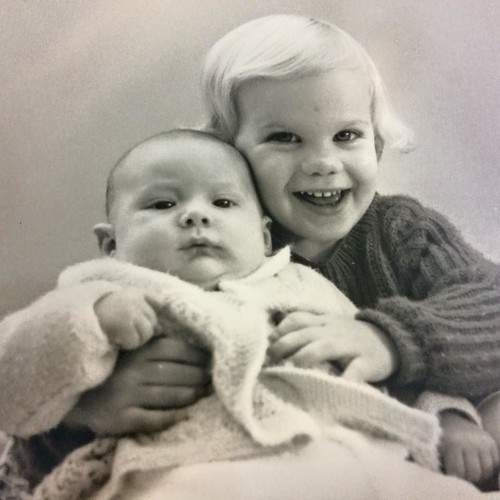Have you ever stopped to think about what it would be like to lose your sight? I’m a very visual person and can only imagine how devastating it would be.

However, recently my sister experienced it first hand when she suddenly went blind in one eye.
It started with a tear in her retina – she had laser surgery to repair it, but alas, this was only the start.
So today I’ve asked her to share her story here.
Over to you, sissy!
I was at home when I noticed something was wrong with my left eye.
A dozen twirly, dark pieces of string were dancing across my vision, joined soon after by multiple flashes of light – like lightning.
At first, I wasn’t alarmed. A quick check with “Dr Google” however, indicated that it could be serious.
When I called my optometrist, I was told to come straight in. After an eye exam, I was referred to an eye specialist and underwent urgent laser surgery for a retinal tear.

Problem Solved … Or was it?!
It seemed that my troubles were over, and I breathed a sigh of relief.
A month later, I suddenly lost sight in the same eye. This was different, though, as my vision was obscured by a thick, cloudy grey fog. By now, I was alarmed, especially since I was driving at the time.
Within an hour I was in the emergency department of the city’s largest hospital where an eye exam, ultrasound and scan revealed a further retinal tear and bleeding into the jelly of the eye (called a Vitreous Haemorrhage).
It was decided that emergency cryotherapy was the best form of treatment to begin with. Injections in and around the eye delivered local anaesthetic and the tear was repaired.
While the initial results looked promising, the bleed meant that doctors couldn’t be sure they had repaired all of the tear, so I was booked in for a vitrectomy – a surgical procedure where the blood and jelly of the eye are removed to get a better look at the retina.
Day Surgery
General anaesthetic made sure that I didn’t move whilst the surgeon made small cuts into the white of the eye. The vitreous jelly material was removed with special instruments and replaced with a saltwater solution.
Now that the back of the eye could be seen clearly, the surgeon discovered that the edges of the tear were lifting away from the retina (detaching). Further laser surgery was performed, then an air bubble and stitches were used to anchor the retina in the correct position.
A short time later, I awoke in recovery. My eye was covered in a thick dressing that was removed the following day by the surgeon inspecting his handiwork. Surgery had been a success, but my vision wouldn’t return for some weeks.
Recovering from Vitreous Haemmorhage
After surgery, I experienced:
- Bruising near the eye
- Swelling of the eyelid
- A sore, sandy, gritty sensation in the eye
- Redness
- Sensitivity to light
- Sticky, yellow discharge from the eye
- Throbbing and tenderness at the site of the tear

For 4 weeks, I put anti-inflammatory and antibiotic eye drops in the eye every four hours, setting alarms in my phone to make sure I didn’t forget. At night, I wore an eye shield to protect the retina whilst sleeping.
A few days later, I could see a black horizontal line across the eye, but everything else was still cloudy and blurry. The black line was from the air bubble, which gradually shrank and disappeared after the first 2 weeks.
My vision improved slowly as the blurriness gradually dissipated, but it took the full 4 weeks before I could see clearly. When sight did return, I was troubled with double vision for a few days, which is common.
For the first few weeks, I spent a lot of time at home in a darkened room. I could watch some tv but found that relying heavily on my right eye led to constant headaches. It was soothing to rest with both my eyes closed and I listened to music to stave off boredom.
Activities with frequent head movements such as exercising, shopping, cooking, cleaning, or gardening were out of bounds so that the retina had time to heal. I found my sight wasn’t good enough to drive, or to use my laptop or mobile phone, but the thing I missed most of all was reading!
Three weeks after surgery, out of the blue, I developed an eye infection. I’m not sure why it happened. Once again, my eye was sore and weeping bloody, yellow pus but thankfully strong antibiotic ointment worked within a few days.

Why did it happen?
As we get older, the vitreous jelly in our eyes shrinks and becomes “sticky”. The vitreous can then stick to the retina and pull hard enough to tear it. When the retina tears, a blood vessel is broken, and blood is released into the vitreous.
The most common risk factors for retinal tears are increasing age and being short-sighted. I fit into both categories, although at 54 my surgeon considers me ‘young’!
I’m thankful that prompt treatment saved my eyesight, but it shocked me how quickly I lost my vision. If you experience any of the same symptoms, get them checked out ASAP.
Several weeks on … the sight in my left eye is noticeably weaker. I really should have stronger glasses but have been advised to hold off for now, as it is highly likely that a cataract will form over the coming months and my vision will change again after that surgery.
Wow. What an ordeal!
Thank you sissy for sharing your story. It’s a good reminder for all of us to never take our eyesight for granted and to seek out medical help if we are experiencing any issues, as well as to make time for an eye exam every year or two (Ahem. Speaking to myself here … I know I’m overdue for my next eye checkup!).
Have you ever heard of vitreous haemmorhage before? Although I’d heard of a torn retina before (the husbear had one last year), this was a first for me!



